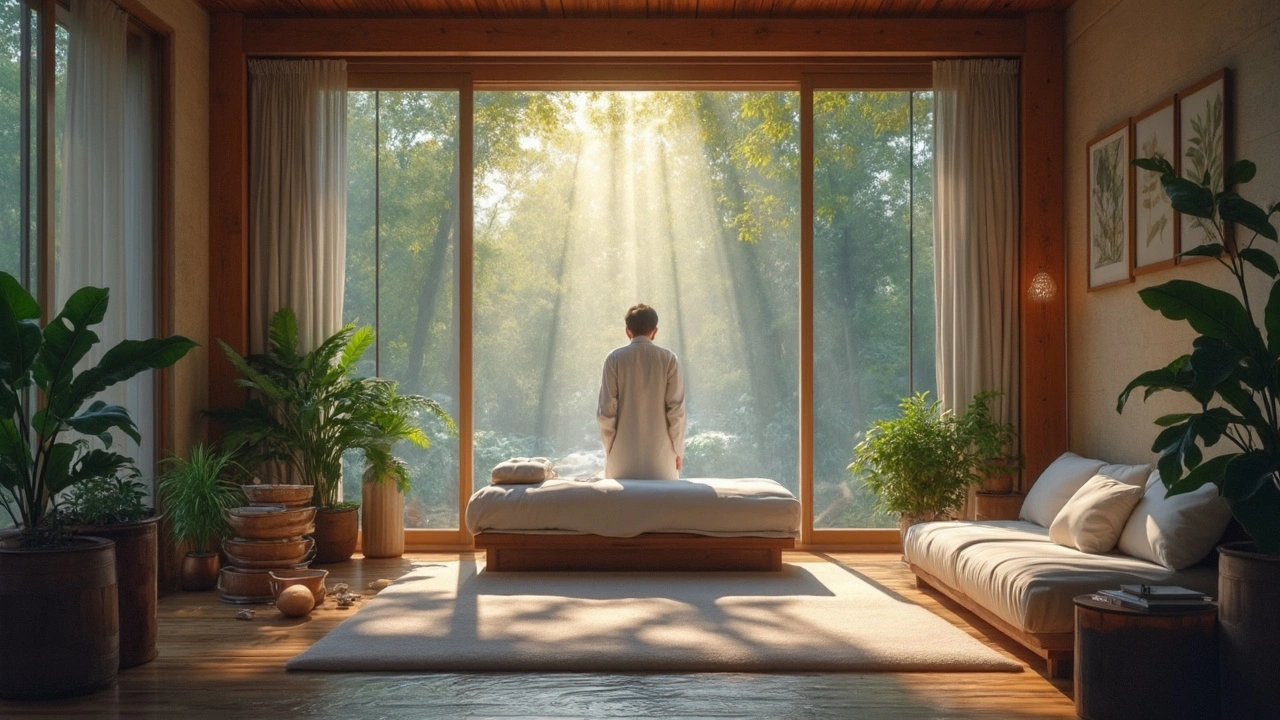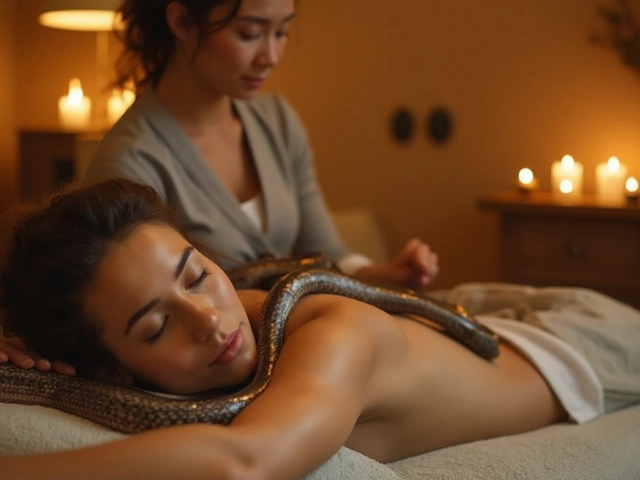Your Health Matters: Unpacking Craniosacral Therapy

Craniosacral therapy, sounds a bit fancy, right? But it's actually a pretty straightforward concept. This therapy focuses on the body's craniosacral system, which includes the membranes and fluid surrounding the brain and spinal cord. It's all about using a gentle touch—think lighter than the weight of a nickel—to maybe help your body heal itself. Some folks say it's like hitting the reset button for your central nervous system.
Now, why does this matter to you? Well, if you're like me and always on the hunt for ways to feel better and stay healthy, this might be worth a look. Some people rave about it helping with headaches, neck pains, and even stress. But hey, we're all different, so results can vary from person to person.
Got you curious? We'll dig deeper into what this therapy can offer, who it might suit best, and how you can get into it if it sounds like your cup of tea. Don't worry, it's not all mystical; we'll keep it real and practical.
- Understanding Craniosacral Therapy
- Health Benefits of Craniosacral Therapy
- Who Can Benefit from Craniosacral Therapy
- Getting Started with Craniosacral Therapy
Understanding Craniosacral Therapy
Alright, let's break down what craniosacral therapy really is. Imagine it as a gentle, hands-on method where therapists use their light touch to examine the membranes and movement of the fluids in and around the central nervous system. The idea is to ease tension and improve the overall health of the central nervous system, which could have ripple effects on the whole body.
Developed by John E. Upledger in the 1970s, this therapy is based on the concept that the rhythm of the craniosacral system can impact overall health. The health benefits become more apparent as therapists look to improve the flow of cerebrospinal fluid, reduce blockages, and help restore natural movement patterns in the body's tissues.
People often describe the experience as being deeply relaxing. The practitioner starts by gently placing their hands on the client's body, usually the head, feet, or along the spine. They're feeling for the craniosacral rhythm, which is slightly slower and more subtle than your heartbeat or breathing.
Here's the question: how can such a light touch make a difference? The belief is it encourages the body's own ability to correct itself, finding balance and harmony. Clients sometimes report reduced pain, migraines, and reduced stress levels when part of a broader holistic treatment plan.
Curious about who usually seeks out this kind of treatment? Typically, folks dealing with chronic pain, trauma recovery, or even infants with birth traumas might go for craniosacral therapy. But it's also grown popular among healthy individuals looking to maintain wellness and balance.
You might wonder about its legitimacy. While mainstream medical science is still exploring its full potential, some practitioners believe its anecdotal successes make it worth considering as a complementary approach. If you're thinking of giving it a try, chat with a practitioner who's well-trained, ideally certified by a reputable body.
Health Benefits of Craniosacral Therapy
So, what's the big deal with craniosacral therapy? Turns out, quite a few folks have found this gentle technique to be a game-changer for their health. Here's how it might help you out.
First off, people have reported feeling less stressed after a session. The light touch and focus on the craniosacral system are thought to help calm the nervous system, which can lead to a feeling of relaxation. And who doesn't need a bit more chill in their life?
Craniosacral therapy might also be a winner if you get headaches or migraines. By easing tension in the membranes surrounding your brain and spine, it could potentially reduce those dreaded pounding head pains. It's not a magic bullet, but some say it’s helped them manage the frequency and intensity of their headaches.
Folks dealing with chronic pain and muscle tension, listen up. Practitioners believe that by gently guiding the movement of your craniosacral system, it might release deep-seated tensions in your body. This could make a real difference for those nagging pain spots that just won't quit.
Now, if you're a parent or know someone struggling with issues from injuries or trauma, this therapy might offer some support. Some case anecdotes suggest it can be beneficial in reducing symptoms associated with trauma, helping the body find its way back to balance.
- Stress Reduction
- Pain Relief
- Headache Management
- Support for Trauma Healing
There are plenty more individual stories out there, and no two experiences are the same. A lot of benefits are based on personal reports, so it's worth chatting with a practitioner to see if it might be right for you. After all, your health journey is totally unique!

Who Can Benefit from Craniosacral Therapy
Alright, so you're probably wondering if craniosacral therapy is just for those who are super into the alternative medicine scene, right? Not exactly. This gentle approach can actually be beneficial for a whole range of people. Let's break it down.
If you're dealing with stress, chronic pain, or tension, craniosacral therapy might help calm things down a notch. Think of it like giving your nervous system a soothing hug. People with conditions like headaches or migraines, neck and back pain can often find some relief through these sessions.
But that's not all. It's not uncommon for folks recovering from trauma, whether physical or emotional, to seek out this therapy. The goal here is not just about healing the body, but also addressing the mind. So if anxiety or PTSD is part of your story, this might be worth a shot as part of a broader healing plan.
- Stress and tension relief
- Chronic pain management
- Headaches and migraines
- Recovery from trauma
Now, let's talk about parents for a sec. Ever heard of craniosacral therapy for babies? Some parents swear by it for helping their little ones with colic, sleep issues, or even after difficult births. The idea is to gently assist the body in readjusting and finding balance.
Before jumping on board, though, have a chat with a healthcare provider. While craniosacral therapy is generally safe, it's always smart to make sure it aligns well with your personal health needs and goals.
Getting Started with Craniosacral Therapy
So, you’re interested in dipping your toes into craniosacral therapy? Great choice! Let's talk about how you can kick things off. This isn’t like your typical massage or spa day, so knowing a bit about what to expect can make the whole experience smoother.
First off, find a licensed and reputable therapist. This is super important because you want someone who knows their stuff. Check credentials, maybe read online reviews, or ask friends if they know someone good. Word of mouth can be pretty reliable.
Once you’ve picked a therapist, be prepared for your first session. You'll likely lie fully clothed on a massage table while the therapist uses gentle touches, focusing on areas around your head, spine, and pelvis. It might feel like they’re not doing much, but that's kind of the point. The aim is to subtly help your body's natural rhythm.
Here are some tips for your first session:
- Wear comfortable clothing. You want to be able to relax fully.
- Try to go in with an open mind and no specific expectations.
- Communicate any issues or areas you’d like to focus on with your therapist beforehand.
- Remember that it might take a few sessions before you notice changes.
You might wonder how often you should go. It depends on what you're looking to achieve. Some people go weekly, while others find a monthly visit works fine. Just like Maximus and Nimbus have their quirks, your frequency will depend on your body's needs.
To give you a rough idea, in 2024, a survey showed that about 30% of people trying craniosacral therapy noticed a difference after just a few sessions, especially in managing stress and improving sleep. While those numbers might not tell the whole story, it's always interesting to see how it works for different folks.
Once you start, it's all about listening to your body and seeing if craniosacral therapy fits your health journey. Happy healing!





